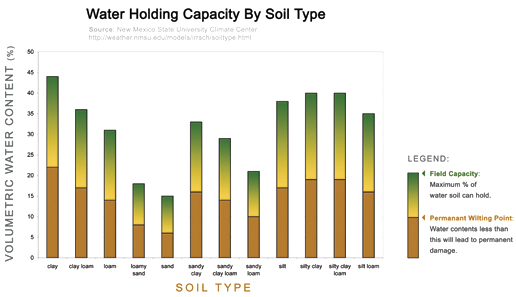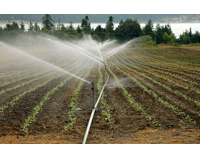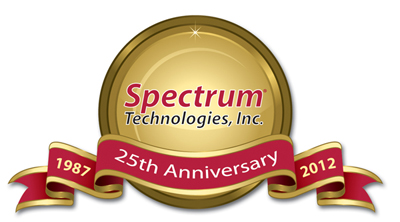|
News from Doc Green!
Phew!! It’s been a long, hot summer hasn’t it? I don’t know about you, but all this hot, dry weather really makes me thirsty. And, nothing eases that thirst like a good irrigation…to increase water-holding capacities and  lower soil moisture tension for my friend the soil, which I greatly depend upon. You had better believe it; with all the extra work this summer to remain healthy, the soil, and me could truly use a refreshing irrigation. lower soil moisture tension for my friend the soil, which I greatly depend upon. You had better believe it; with all the extra work this summer to remain healthy, the soil, and me could truly use a refreshing irrigation.
This Month's Topic: Soil Moisture and
Irrigation for Crops!
Supplementing rainfall or lack of rainfall with water supplied by irrigation systems through periods of soil-water deficit can help to increase yields and improve the quality of harvested plant products. This is particularly important for high-value crops such as veg¬etables, fruits and ornamentals, where reductions in quality can result in diminished prices or ultimately the complete unsuitability of a crop for market. Irrigation is also critical for turf for either aesthetic appeal or athletic playability.
The water holding capacity of the soil has a great impact on deciding how often irrigation is required. Poor structure, low organic matter, low carbonate content and presence of stones all reduce the moisture storage capacity of a given texture class. Potatoes that require 0.25 inches of water per day will require irrigation when the root zone moisture depletion reaches 40%. A sandy loam soil that holds 1.5 inches of water per foot might require irrigation every three to four days. Agronomic crops such as hay and small grains can also benefit from irrigation. However, the econom¬ics of irrigation also depend on markets, so potential returns must be enough to justify the cost. For instance, high-quality hay markets provide premium prices in some hay growing areas.
Diverse soil textures have different soil water holding capacities. Clays store large amounts of water, but because they have high wilting points, they need significant rain to be able to supply water to plants. On the other hand, sands have limited water storage capacity, but because most of it is available, plants can make use of light showers regardless of how dry they are before the shower. Plants growing in sand generally have a denser root system to enable them to access water quickly before the sand dries out.
The following table illustrates the water holding capacities of general soil texture types.

Irrigation Systems and Solutions
Overhead and drip irrigation systems are both commonly used in high-value crop production. There are many variations of each of these application methods, and the  best type for an individual grower depends upon numerous things including cropping system and rotations, soil type and topography, available capital, equipment and labor, quantity and quality of water, power requirements, and total area irrigated, to name a few. Overhead irrigation imitates rainfall and is necessary for areas that receive insufficient amounts of natural precipitation. Examples of overhead irrigation would be a center pivot system in a row crop field or a fixed spray nozzle irrigating a golf course green. For agricultural crops grown on fields that have surface slopes that make it difficult or impossible to irrigate with surface methods, pivot irrigation is the most attractive option. best type for an individual grower depends upon numerous things including cropping system and rotations, soil type and topography, available capital, equipment and labor, quantity and quality of water, power requirements, and total area irrigated, to name a few. Overhead irrigation imitates rainfall and is necessary for areas that receive insufficient amounts of natural precipitation. Examples of overhead irrigation would be a center pivot system in a row crop field or a fixed spray nozzle irrigating a golf course green. For agricultural crops grown on fields that have surface slopes that make it difficult or impossible to irrigate with surface methods, pivot irrigation is the most attractive option.
Drip irrigation supplies small amounts of water directly to the root zone. Water is applied by emitters placed in precise locations. This is done slowly to allow for proper infiltration with minimal waste. Drip lines can be installed either on or below the soil surface. Further efficiency can be achieved by installing the drip system under plastic mulch, which reduces surface evaporation and suppresses weed pressure without the need for herbicides.
Regardless of your irrigation technique, variability in topography, soil types, and crop uptake will lead to some locations being wetter or drier than others in the same field. Consequently, monitoring soil moisture conditions is essential in order to apply adequate amounts of water when and where crops need it.
Irrigation Management:
The principles of effective irrigation management and scheduling are the same no matter how you apply the water. The key to scheduling is accurately determining the amount of water in the soil. Tracking soil-water content helps decide both when to irrigate and how much water to apply at each irrigation. Irrigation management contributes to productive and profitable production of high-value crops.
Many factors affect crop-water use. Both yield and quality can be improved with efficient irrigation management and effective irrigation scheduling. By the time you can visually see that a crop needs water, damage has already occurred.
Monitoring soil water is the proactive approach with anticipating crop-water needs rather than the reactive approach when it may be too late due to crop-water stress

Spectrum’s WatchDog® irrigation stations are an affordable way to monitor soil moisture over time at specifically selected locations and help with determining your irrigation schedule. The stations come pre-configured with two to four soil moisture sensors so you can track how irrigation and rain events are impacting moisture throughout the root zone. Stations are available for WaterScout  soil moisture sensors so you can measure volumetric water content or soil moisture tension. Sensors should be placed just above and just below the root zone to give a complete picture of when, and for how long, water was available to the plant. WatchDog irrigation stations can be located almost anywhere you need to collect data. soil moisture sensors so you can measure volumetric water content or soil moisture tension. Sensors should be placed just above and just below the root zone to give a complete picture of when, and for how long, water was available to the plant. WatchDog irrigation stations can be located almost anywhere you need to collect data.
WaterScout Irrigation Stations:
-
Various models to choose from (Model 1200, 1400, 2000, 2400) with pre-configured stations that measure soil moisture with up to four (4) WaterScout sensors.
-
Add a cellular or wireless modem to the 2400 Mini Station to remotely monitor current conditions.
-
Micro Stations (Model 1200 & 1400) also include the Protective Sliding Enclosure
-
Includes WatchDog Station and WaterScout SM 100 Soil Moisture Sensors with 20 ft. (6 m) cables
WatchDog 2000 Series Irrigations Stations are available with Wireless Communications for remote locations where it is difficult or undesirable to actually visit the station, Spectrum offers a variety of wireless connection options so you can get the data whenever you need it. For more remote stations, connections via the cellular telephone or satellite networks are available. All remote connection options are compatible with SpecWare software.
WatchDog 1400 SMEC Irrigation Station
Affordably monitor, compare, evaluate soil moisture levels, salts, and soil temperature from two user-defined soil depths. The salinity of the root zone is a critical element for healthy plant growth. Irrigation, fertilizers, and crop demand all impact salt concentrations. High levels can damage the plant: low levels can lead to nutrient deficiencies.
-
Includes WatchDog 1400 Micro Station, Waterproof Enclosure, and two (2) WaterScout SMEC 300 Soil Moisture/EC/Temperature Sensors with 20ft cables.
-
WaterScout SMEC 300 - Track water, salts, and soil temperature: all with a single sensor!
-
WatchDog 1400 Micro Station - Delivers the information you need for timely, accurate data that will result in increased profits.
-
The LCD display confirms station operation and provides current sensor readings. View soil moisture prior to irrigating – without downloading to a PC.
-
Waterproof Enclosure – Clamshell enclosure provides protection from water, perfect for placing into irrigation controller boxes.
WatchDog 1000 Series Watermark Irrigation Stations
WatchDog 1000 Series Watermark Irrigation Stations. 4 models to choose from, these pre-configured stations measure soil moisture with up 4 Watermark sensors.
|
We'll be at Irrigation Show in September!
Visit our booth #635 and see our latest irrigation measurement technology products and learn how we can help your business continue to grow.

|
This year marks our 25th year of doing business!

We want to thank the many researchers and customers who have contributed to our success. We look forward to serving and working with you on our continued goal to be the partner you can count on for affordable Plant Measurement Technology
|